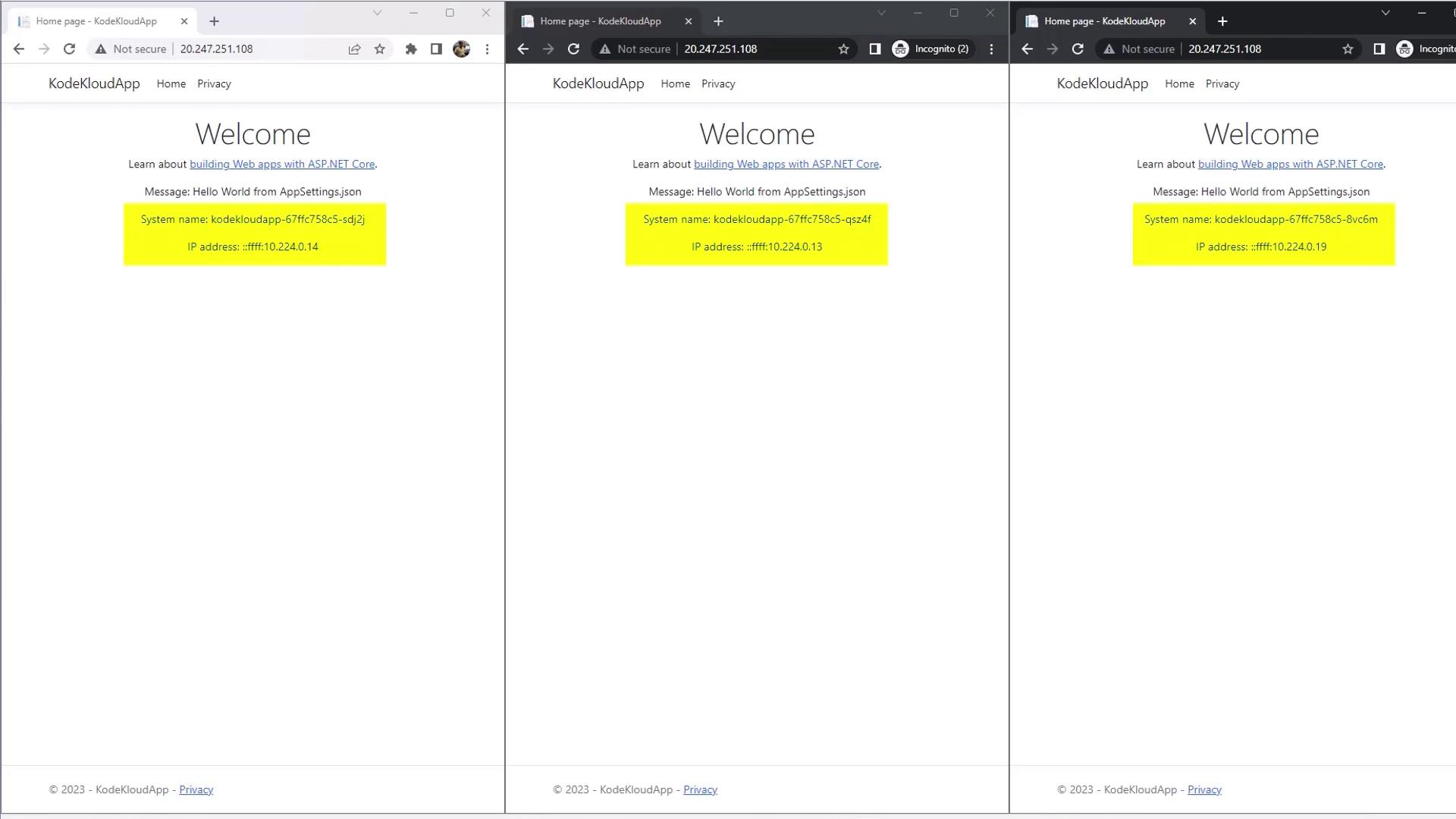Azure Kubernetes Service
Working with AKS
Scaling the Deployment using kubectl
In this tutorial, you’ll learn how to scale an Azure Kubernetes Service (AKS) deployment and understand the per-node pod limit enforced by Azure CNI. We’ll cover:
- Inspecting your current Deployment and Service
- Scaling the Deployment to 5 replicas
- Hitting the 30-pod per-node limit
- Examining Namespaces and system pods
1. Inspect the current Deployment and Service
Before scaling, verify your application’s replica count and external endpoint.
# Check the Deployment replicas
kubectl get deployments
# Output example:
# NAME READY UP-TO-DATE AVAILABLE AGE
# Find the LoadBalancer’s public IP
kubectl get service
# NAME TYPE CLUSTER-IP EXTERNAL-IP PORT(S) AGE
# kodekloudapp LoadBalancer 10.0.199.121 20.247.251.108 80:30895/TCP 73m
# kubernetes ClusterIP 10.0.0.1 <none> 443/TCP 124m
2. Scale to 5 replicas
Increase your Deployment to five pods:
kubectl scale deployment kodekloudapp --replicas=5
kubectl get deployment kodekloudapp
# NAME READY UP-TO-DATE AVAILABLE AGE
# kodekloudapp 5/5 5 5 76m
Validate load balancing
Open three incognito browser windows and navigate to your Service’s public IP. You should see traffic routed to different pods:

3. Scale to the pod limit (30 replicas)
When you created the AKS cluster, you configured Azure CNI with a maximum of 30 pods per node. Let’s push the Deployment to that limit:
kubectl scale deployment kodekloudapp --replicas=30
kubectl get deployment kodekloudapp
# NAME READY UP-TO-DATE AVAILABLE AGE
# kodekloudapp 16/30 30 16 78m
Only 16 pods are running; the rest remain Pending:
kubectl get pods
# NAME READY STATUS RESTARTS AGE
# kodekloudapp-677fc758c5-5k92g 0/1 Pending 0 57s
# kodekloudapp-677fc758c5-bbp84 0/1 Pending 0 57s
# ...
Filter non-running pods
List pods that aren’t in the Running phase:
kubectl get pods --field-selector=status.phase!=Running
Inspect pod scheduling events
Describe one pending pod to see why it isn’t scheduled:
kubectl describe pod kodekloudapp-677fc758c5-5k92g
In the Events section you’ll find:
Warning FailedScheduling 2m default-scheduler 0/1 nodes are available: 1 Too many pods.
Normal NotTriggerScaleUp 110s cluster-autoscaler max node group size reached
4. Namespaces and system pods
AKS uses several namespaces to isolate workloads. System pods in kube-system count toward your per-node limit.
kubectl get namespaces
# NAME STATUS AGE
# default Active 129m
# kube-node-lease Active 129m
# kube-public Active 129m
# kube-system Active 129m
Namespace overview
| Namespace | Purpose | Pod Count |
|---|---|---|
| default | User applications | 16 |
| kube-node-lease | Node heartbeat leases | 0 |
| kube-public | Public config and resources | 0 |
| kube-system | Core cluster services | 12+ |
kubectl get pods --namespace kube-system
# NAME READY STATUS RESTARTS AGE
# ama-logs-rs-7f8bcb7c6f-5dlqq 1/1 Running 0 131m
# coredns-59b6bf8b4f-lwt4c 1/1 Running 0 131m
# metrics-server-7d74d8758-wfsdd 2/2 Running 0 130m
# ...
Warning
Azure CNI assigns IPs from your VNet based on the --max-pods setting at cluster creation. You cannot change this limit post-creation.
Next steps
To work around the per-node pod limit, consider:
- Deploying multiple node pools with different
--max-podssettings - Switching to Kubenet or Azure CNI Overlay networks
- Splitting workloads across separate namespaces and node pools
Links and References
Watch Video
Watch video content